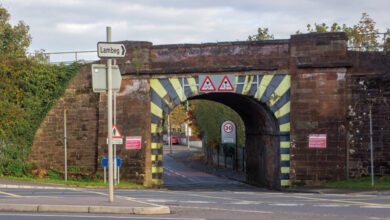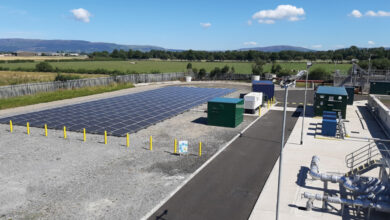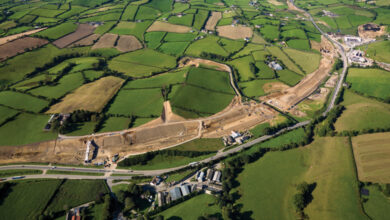Northern Ireland planning
The introduction of the Planning Act 2011 transferred the majority of planning responsibility to local councils from 1 April 2015. Following the publication of the latest annual statistics, agendaNi analyses the outcomes of the new system.
In the past two years the level of planning applications being submitted has returned to being higher than the number of decisions, a trend last seen prior to the economic downturn. While the number of planning decisions currently being issued by councils is still over 60 per cent below peak levels in 2005/2006, the volume of applications received has started to stabilise since 2012/13. In 2015/16 the number of planning applications received in Northern Ireland by local councils and the Department for Infrastructure (DfI) was 12,220, a 5 per cent decrease on the previous year (12,864). The figure represents a levelling off in the volume of applications received in the last two years, after a trend of constant decline from peak levels in 2004/05 (36,593).
Statistics published by the DfI via information gathered by the Northern Ireland Statistics and Research Agency show that Belfast City Council (1,592) was the highest recipient of planning applications between to 2015/16, followed by Newry, Mourne and Down (1,443). The volume of applications received by the two councils represented almost one quarter of the Northern Ireland total. The lowest levels of applications were received on Antrim and Newtownabbey (722) and Mid and East Antrim (819). Six of the 11 new councils recorded a decrease in applications. The most significant of these were in Antrim and Newtownabbey where applications were down 16 per cent; Armagh, Banbridge and Craigavon fell by almost 16 per cent and Fermanagh and Omagh was down 14 per cent. Mid and East Antrim and Causeway Coast and Glens recorded no change in the volume of applications received but levels were up in Belfast (5 per cent), Derry City and Strabane (5 per cent) and Mid Ulster (4 per cent). The contrast between levels of planning applications across Northern Ireland in the past decade is most notable when presented in terms of portion of population. Last year there were 66.4 planning applications received per 10,000 people in Northern Ireland, significantly lower than 2004/05, when the rate was 214.6.
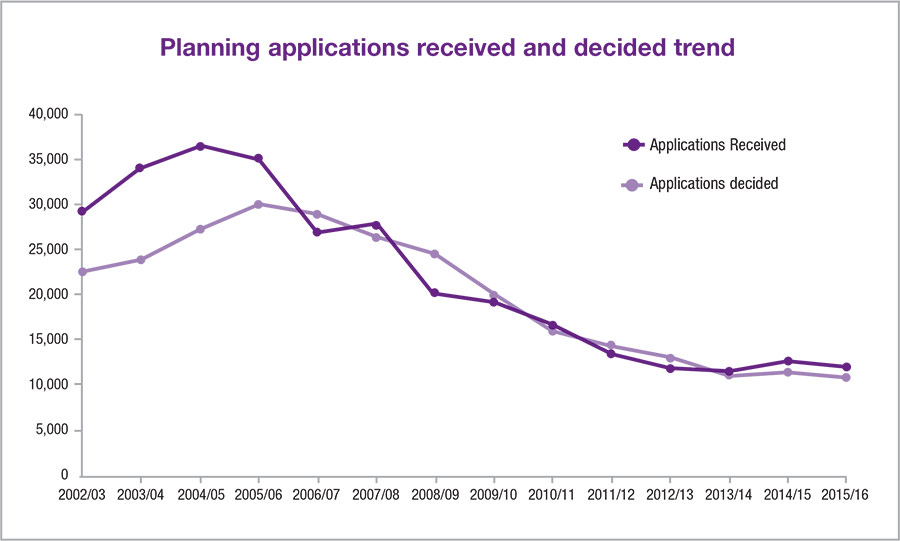
The 11,034 planning decisions taken by local councils in 2015/16 was down 5.3 per cent on the previous year and almost one third of the 30,161 recorded in the peak year of 2005/06. Following the transition of planning authority, the level of decisions dropped shortly in the first quarter of 2015/16 but then increased quarter on quarter. In the last quarter the level of decisions exceeded the level of applications for the first time since 2013/14. However, throughout the full year decisions taken remained 9.7 per cent lower than the volume of applications received. Overall approval rates for the year were 93.7 per cent, half a per cent up on the previous year. During the year planning approval rates varied across councils from a high of 96.7 per cent in both Derry City and Strabane and Mid Ulster to 90.8 per cent in Newry Mourne and Down. Six of the 11 councils had an approval rate lower than the Northern Ireland average rate of 93.7 per cent.
By the end of March 2016, there were 1,445 live applications, which were in the system for longer than one year. One out of five applications were in the system for over a year by March 2016, compared to one in seven at the end of March 2015. The proportion of live applications at the end of March 2016 in the system for one year (19.6 per cent) has increased from a rate of 14.5 per cent in the last year. Antrim and Newtownabbey had the lowest proportion of cases over one year old (11 per cent), while Derry City and Strabane (29.2 per cent) had the highest.
The Department
The new Department for Infrastructure still retains responsibility for applications of regionally significant developments and for legacy ‘Article 31’ applications. The Department also has the power to call in both major and local development applications from councils. By the end of March 2016 the Department controlled six ongoing regionally significant development (RSD) applications, eight called in, three conservation area consent (i.e. consent to demolish) and 28 retained applications. Of the six RSD’s, four of which were for renewable energy proposals, none were decided during 2015/16. DfI reached decisions on 18 applications last year. Nine were on ‘retained section 29’ (former Article 31), five decisions were reached on ‘retained section 29’ and a further four decisions were on ‘called in’ applications. The overall average processing time in 2015/16 for applications processed by the Department to a decision or withdrawal was 137.2 weeks.
Major planning
Aside from RSD applications, councils received 145 major planning applications in 2015/16, the majority of which composed of multiple housing, commercial, government and civic developments. A total of 272 decisions were made on major planning applications and 14 were withdrawn. A “very significant” drop in major applications in the last three quarters of the year are explained by the introduction of pre-application community consultation of a minimum of 12 weeks becoming a requisite from 1 July 2015. Belfast City (35), Newry, Mourne and Down (20) and Lisburn and Castlereagh (16) received the majority of the major applications. Belfast City (51) issued the most decisions on major applications, followed by Causeway Coast and Glens (35) and Newry, Mourne and Down (29). An average processing time across all 11 councils of 46.4 weeks was 16 weeks longer than the statutory processing time target of 30 weeks. Antrim and Newtownabbey had the shortest processing time of 28.2 weeks, while Fermanagh and Omagh had the longest with an average of 70.2 weeks. Of the 11 councils only Antrim and Newtownabbey met the 30 week target for major applications.
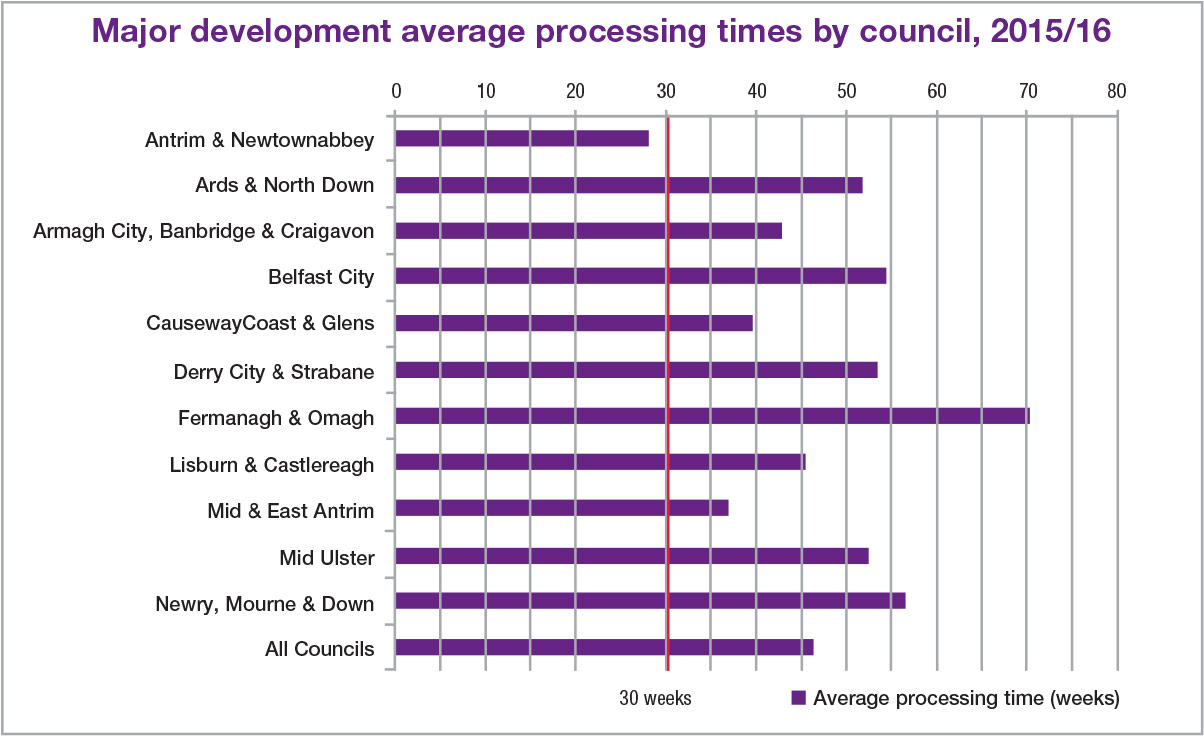
Local development
Local development planning applications, made up of mostly residential and minor commercial, were 12,069 of the of the overall total. Belfast City (1,557), Newry, Mourne and Down (1,423) and Mid Ulster (1,371) received the highest number of local planning applications. The most decisions were taken by Belfast City (1,265), Mid Ulster (1,218) and Armagh City, Banbridge and Craigavon (1,202) and the same three councils were responsible for taking the most decisions. Processing time across all councils was 19.4 weeks, over four weeks longer than the statutory target set at 15 weeks. Antrim and Newtownabbey recorded the shortest processing time of 14 weeks, while Newry, Mourne and Down had the longest of 34.8 weeks. Three councils, Antrim and Newtownabbey (14 weeks), Fermanagh and Omagh (14.4 weeks) and Mid and East Antrim (14.4 weeks) were within the 15 week target.
Residential applications received during 2015/16 made up 58.9 per cent of all Northern Ireland planning applications, almost 2 per cent higher than the previous year. Although the 7,192 applications are higher in number than the low of 6,278 in 2012/13, the 2 per cent decrease in the last year may represent a stalling of gradual recovery. Lisburn and Castlereagh (69.2 per cent) had the highest proportion of applications designated for residential development, while Belfast City (43.9 per cent) and Derry City and Strabane (45.3 per cent) had the lowest. The number of residential planning decisions taken in 2015/16 increased by over 2 per cent but is a slower rate than the increasing trend since the low. The approval rate of residential planning for Northern Ireland in 2015/16 was 93.9 per cent. Approval rates were highest in Derry City and Strabane (97.9 per cent) and (97.3 per cent) but lowest in Newry, Mourne and Down (88.8 per cent). The overall 5 per cent fall in applications was driven by a 26.5 per cent decline in government and civic applications and a 15.3 per cent decrease in change of use applications. Mixed use applications grew by 35.6 per cent from 331 to 449.
Enforcement
During 2015/16 there were 24 prosecutions initiated in relation to planning in Northern Ireland, the lowest so far and down by 11 on the previous year. However, the number of enforcement cases opened (2,914) is the highest number of any cases opened since 2010/11 (3,117). Previously a trend existed that more cases were closed than opened over a year but in 2015/16 the 271 cases closed were 9.3 per cent lower than the number opened.
Renewable energy
Last year saw the lowest number of renewable energy applications received in Northern Ireland (329) since 2009/10. It compares to a peak in applications during 2011/12 of 820 applications, shortly after the Northern Ireland Executive set new targets for electricity consumption from renewable sources. A reduction of government funding and a lack of connection space on the power grid may explain a 38.6 per cent drop in applications received in 2015/16 from the previous year. In total, 404 applications were decided, a decrease of 29.9 per cent and the average processing time was estimated at 49.4 weeks. More than 70 per cent of applications were for single wind turbines (245) but although still the most popular renewable energy application, applications for single wind turbines are down 41.8 per cent on the previous year. Fermanagh and Omagh (50), Mid Ulster (48) and Causeway Coast and Glens (43) were the most popular councils for renewable energy applications, while Belfast City (3) and Lisburn and Castlereagh (15) received the least.



